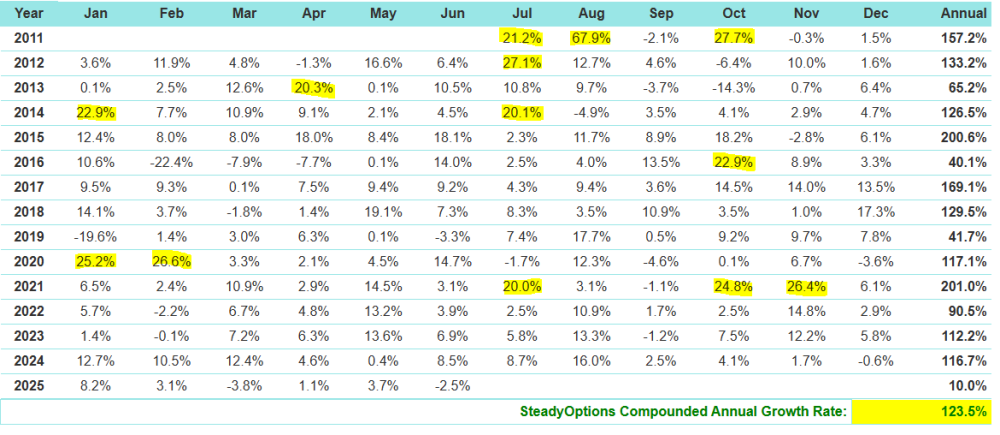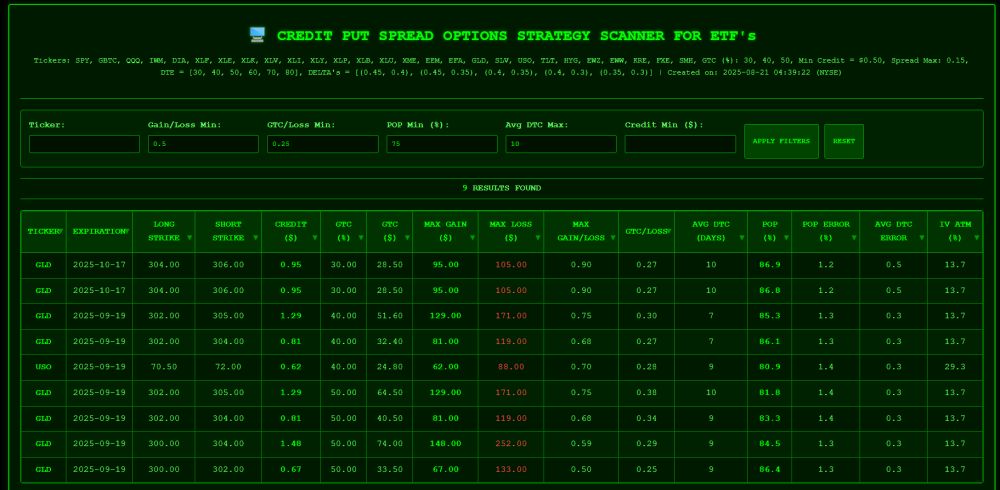SteadyOptions is an options trading forum where you can find solutions from top options traders. Join Us!
We’ve all been there… researching options strategies and unable to find the answers we’re looking for. SteadyOptions has your solution.
Leaderboard
Popular Content
Showing content with the highest reputation since 12/10/24 in all areas
-
As all our American friends are recovering from their dinners and drinks, a bit of light humour on this Monday. A friend of mine knew I was an active trader and asked whether I could share my portfolio with him and we could then discuss it. To be fair to him, he was a complete newbie and I restricted myself to sharing my shares portfolio explaining that the options bit is perhaps a bit complicated. The idea was that we would talk about it and how to build a balanced portfolio, again credit to him he took it seriously and researched the companies in my portfolio perhaps further than even I had. He therefore came prepared with his homework for our discussion this weekend and proudly laid out what he found, prefacing it with: "I researched all the companies in your portfolio, there is just one I had an issue with: ALPHABET, I googled it but can't find out which company it is."10 points
-
In the name of full transparency, I would like to address some issues regarding SteadyOptions recent performance. I will separate the analysis into several separate posts. Our performance in the recent months is not in line with our long term returns, as everyone can see on the performance page. The main reasons for the recent underperformance: We are struggling with a change in the fundamental behavior of volatility at the moment. Our trades rely on RV and therefore also IV and this has not been acting as expected. Periods of extended VIX decline have always been some of our worst performers. The main problem now is that we have been in a long period of VIX decline that’s been going for months - there have been a few spikes but in general VIX has gone from 30+ to the 20’s to the mid teens (and making things worse is many periods of minimal stock price movement during this timeframe). Our core trades do well when volatility is stable or rises. When volatility started to drop, it created some large percentage losers on a few trades that had an oversized negative impact on the portfolio performance. We had much less trades in 2025, which made the impact of those larger losses bigger. We had less trades because some options became very expensive, so it became difficult for many trades to fit into a $1K allocation, and for many stocks with moderate liquidity in normal times, now had less liquidity and very wide bid/ask spreads. This made them much more risky to use for options trades as slippage was a big concern. We used some directional trades, and the stocks did not follow historical patterns in those trades. When a directional trade goes against you, losses can grow very quickly. This is what happened with TTD, XYZ, KO, FL etc. Some of the non directional trades also experienced outsized losses. We will reduce the number of directional trades going forward. We used less calendars than usual because many of them were way too expensive compared to previous cycles. Now with VIX in the mid teens, we expect to trade more calendars, which is one of our best performing strategies. We are having extensive internal discussions on how to adapt to the current environment. Our strategies are designed to make money in any market. They are not guaranteed to make money, but our long term objectives are still in place. No strategy works all the time. There’s no room for ‘never’ or ‘always’ in the financial markets.8 points
-
As has become my end of year tradition, I’ve broken down the Steady Options 2024 trade performance by trade type. Numbers were taken directly from the data in the Performance screen (plus some recently closed trades). Here’s are this year’s stats along with some comments from my perspective. Where applicable, I added totals from prior years for comparison. 2024 was a year where market volatility was calm with VIX under 20 for the first half of the year. The second half of the year turned more volatile with several VIX spikes into the 20’s and beyond, along with a general run-up into the election and a decline afterwards. So, we had both calm periods and more volatile periods. Pre-Earnings Calendars 54 Trades – 43 win, 10 loss,1 break-even (81% win) – Average Gain +12.13% 2023: 65 trades (85% win) – Average Gain +9.56% 2022: 11 trades (64% win) – Average Loss -9.55% 2021: 110 trades (79% win) – Average Gain +12.82% 2020: 33 trades (85% win) – Average Gain +21.97% 2019: 54 trades (65% win) – Average Gain +9.27% 2018: 40 trades (78% win) – Average Gain +9.61% 2017: 31 trades (84% win) – Average Gain +13.81% 2016: 44 trades (80% win) - Average Gain +15.07% 2015: 51 trades (80% win) – Average Gain +12.67% 2014: 48 trades (71% win) – Average Gain +13.80% 2013: 24 trades (88% win) – Average Gain +20.60% Comments: We were able to a good number of calendar trades this year, the majority of which occurred during the calmer period of the year when VIX was lower. Very good overall winning percentage and average gain per trade. We avoided big losses that can sometimes happen when stock prices make very large moves. Earnings calendars continue to be a core SO strategy. Straddles/Strangles 57 Trades - 41 win, 15 loss, 1 break-even (73% win) – Average Gain +4.72% Breaking down further by hedged and non-hedged: Non-Hedged – 38 win, 14 loss, 1 break-even (73% win), average gain +5.18% Hedged – 3 win, 1 loss (75% win), average gain +0.95% 2023: 166 trades (64% win) – Average Gain +1.65% 2022: 148 trades (71% win) – Average Gain +4.89% 2021: 129 trades (68% win) – Average Gain +3.27% 2020: 118 trades (67% win) – Average Gain +2.80% 2019: 106 trades (68% win) – Average Gain +3.58% 2018: 72 trades (83% win) – Average Gain +5.40% 2017: 77 trades (79% win) – Average Gain +5.02% 2016: 18 trades (72% win) – Average Gain +5.19% 2015: 44 trades (68% win) – Average Gain +2.61% 2014: 74 trades (62% win) – Average Gain +2.54% 2013: 104 trades (57% win) – Average Gain +1.35% Comments: Lower number of straddle/strangle trades compared to prior years, due primarily to introduction of double diagonal (DD) trades which will be discussed later. Overall winning percentage and average gain per trade were at the upper end of the range based on prior year performance. From a downside risk perspective, only 2 losses above 10%, with one larger loss on a hedged straddle that saw an RV drop orders of magnitude higher than prior cycles. 37% of trades hit 10% gain target, which is at the upper end of the range compared to prior years. Very low risk trades as it takes RV dropping much more than their prior cycle tendencies to be significant losers Double Diagonals DD trades were introduced this year with the goal of having performance similar to straddles/strangles – but have the ability for the trades to be open for much longer periods of time (up to 3 weeks prior to earnings) giving the stock more time to move but still have minimal downside risk. 52 Trades - 38 win, 14 loss (73% win) – Average Gain +4.86% Comments: High winning percentage, with roughly 3 of 4 trades being winners. All losing trades were under 10% losses, majority of losses were under 5%. So this is a very low risk trade type with minimal downside risk Average gain was at the upper end of the range compared with straddle/strangle results of prior years – so the goal of performance being similar to straddles/strangles was achieved. 35% of trades hit 10% gain target, which is at the upper end of the range compared to straddle/strangle trades in prior years. Other Trades Non-Earnings RICs: 4 win, 1 loss (80% win) – Average Gain +3.52%%. These non-earnings trades have higher downside risk if stock price doesn’t move. In this case the 1 loss needed 2 wins to compensate. Hedged ratios and BWBs: 4 win, 7 loss (36% win) – Average Loss -10.55%. These were hedged directional trades, a few oversized losses hurt the average. S&P500 addition date trade: 3 win, 1 loss (75% win) – Average Gain +3.28%. These trades play for stock price decline (or at least staying flat) after the S&P500 addition. The one loser hurt the average as all 3 gains were 10%+. We will likely do trades like things with future S&P500 stock additions. Other: A few successful index Iron Condors and the closure of one long-term UNG ratio diagonal for an oversized loss. Net result of these trades was basically break-even from a percentage gain/loss perspective. Summary 2024 Steady Options model portfolio was up around +118% for the year. This result was right around the average yearly return since SO’s inception. It’s good to be able to say that trades based on SO techniques had such a high return as “average”. As always, I’d like to highlight and thank the SO community. We continue to have a group of very smart people that seems to grow each year who share their ideas and knowledge – this is what makes SO great. Looking forward to 2025. 2023 Year End Performance by Trade Type 2022 Year End Performance by Trade Type 2021 Year End Performance by Trade Type 2020 Year End Performance by Trade Type 2019 Year End Performance by Trade Type 2018 Year End Performance by Trade Type 2017 Year End Performance by Trade Type 2016 Year End Performance by Trade Type 2015 Year End Performance by Trade Type8 points
-
I just received this email addressing some issues SO was facing in the past. I’m not a member anymore but I was and I’m familiar with the strategies. I’m a vol trader since over 20 years so here my 5 cents. There is no fundamental change in volatility. Volatility is behaving as it always does. Volatility reflects the future expectation of movement of an underlying during a certain time frame. One important driver of Volatility are events. The bread and butter of SO, earnings events. Since Trump took office, single stock volatility also incorporates a lot of Macro Event vol and there are a lot more than normal. Best example is the one you used: SOFI. Expiry is 1st of August. Thats Trump’s Tarif deadline and that’s something effecting all businesses. Hence to the normal earnings expectations you got additional macro risk that is specifically fixed on one date. But Trump started taking some expectations out of the deadline by announcing the sending out of letters with deals about two weeks ago and about one week ago announcement of a deal with Japan and on Monday the deal with EU. Hence 1st of August premium got priced out after several parts of the big event got communicated down the road. Thats like pre earning releases. There are a lot of these Macro Events around. Hence, if you trade volatility, you need to be aware of these (extra)events and what the additional premium for these events are on top of the normal micro events. It’s ok trading on backtesting but you need to be aware of the future, hence if the future has addition risk that isn’t replicate in past comparisons. I can clearly say, the SO edge isn’t lost, you just need to be aware what expiry vols you are buying/selling and what (additional) risk they incorporate.5 points
-
A move that will likely help those of you with smaller accounts, it seems PDT minimum account value is about to be reduced to 2K rather than 25K. Timing remains uncertain however. https://www.tradingview.com/news/financemagnates:723d87023094b:0-the-25k-rule-that-s-blocking-millions-from-day-trading-is-about-to-change/5 points
-
My 2 cents worth. I've just been a tradesman all my life, not a professional. But I didn't really become the "go to guy" until I had almost 20 years working on the different kind of machines and control systems that went with them that I worked on, ultimately I ended up with 40 years in that field. I can't count the number of military and corporate "schools and/or classes" I've been to in that time. In periods between contracts I would trade, off and on, for about 20 years. I didn't make very much if any money, but I found it fascinating so I kept playing with it. But I didn't start consistently making profits trading until I finally sold my business and found myself with nothing to do, so I put full effort and full time into learning to trade and that was after 20 years of putzing around with it. Some mentoring classes and over 4 years now on SO and I still make expensive mistakes. It is easy to say "I'm smarter than the average guy so I should be able to do it a lot faster than that", but does that mean you could learn it in 5 years or 3 years or what. Don't quit your day job until you either A: already have your retirement and won't be risking that or B: you have been doing this long enough to be making a consistent profit. I think the stress of HAVING to make a profit from trading is the big filter for traders, when you aren't making any money or worse yet, losing money and you can't pay the rent, the psychology is going to make it that much harder to be successful at trading.5 points
-
A better strategy would be not to trade options that expire the same day. Extremely risky. A better strategy would be to understand what you are doing and asking questions before you place a trade. Learn first, trade later. And if you think education is expensive, try ignorance.4 points
-
I always like to use the analogy of the whole stock market. The stock market indexes produce average return of 10-12%, but that included several drawdowns of 20-30%. Some of those drawdowns lasted months or even years. Nothing goes up in a straight line. So, if you joined the stock market based on a long time return of 10-12%, would you quit if you experienced a 30% drawdown? If the answer is yes, then the stock market is not for you. If the answer is no, then SO is no different. We all would like all our trades to be winners, but we know this is not possible. We know some of the trades will be losers. Many traders think that if a trade has lost money, it was a bad trade. They try to identify what errors they made that lead to losses. Why? "Because I lost money! So surely I have made a mistake somewhere?” Was it the right conclusion? Is any losing trade necessarily a bad trade? The answer is no. No matter how well he executed his trade, there will be losing trades because we are playing a probability game. Trading is a business based on probability. And probability means that sometimes we get what we want, sometimes we don't. And that's the nature of this business. The sooner we accept this, the better we can operate it as a business. To put things in perspective, our model portfolio was up 10% in the first half of 2025. We had few bad trades in July and those put us back few percentage points. While those returns are way lower than expected, they are not the end of the world. We will refine our strategies going forward and I encourage everyone to look at the big picture. It is important to note that consistency in trading is important rather than changing everything when you get an adverse movement. Adaptation rather than revolution over time is the right way to go. Have our strategies lost their edge? This question has been asked many times over the years, basically every time we have a period of dull returns, and the answer each time has been "no, they have not". I believe this time is no different. Profits come in bunches. The trick when going sideways between home runs is not to lose too much in between - Michael Covel Since inception we had 13 months that produced 20%+ returns, and over 30 months that produced 10-20% returns. To win you've got to stay in the game. Our strategies worked very well for us for over a decade, and we have full confidence that they will continue working in the future. Those who have the patience will be greatly rewarded, like in the last 13 years. Members who have been with us from the very beginning know it very well.4 points
-
think my response would have been, "i know a guaranteed way to have an account balance of 1.25 million your first year of trading.. start with 2.5 million and quit when you reach 1.25. many have done it, so can you." HA!4 points
-
If I had to select one thing that causes most traders to fail, it would be wrong expectations. I know I sound like a broken record, but consider this: when someone wants to become and engineer or an accountant, do they expect to achieve this in a few months? No, they fully expect spending at least 4 years and tends of thousands of dollars in University (not to mention becoming a doctor or a lawyer). And yet, many people read all the hype and expect becoming experts after a few months. When I just started SO, I got an email from one of my Seeking Alpha readers. He told me that he is a big fan of my articles and asked how he can learn more. He wanted to make it his new career. He asked me if I can recommend any books or internet sites to learn/practice the options strategies. Then he said that he is new to trading options, he set aside a small amount of money in hopes of doubling it at least yearly. Don't you find it amazing? The guy admits he is new to options, but wants to double the account "at least yearly". My reply was: "There is a lot of hype surrounding options trading. Some "gurus" out there will make you to believe that doubling your account every 6-12 months is an easy task. If it was, we all would be millionaires by now. My advice to you: if you just start options trading, preserving your capital during your first year of trading would be a great achievement" I didn't hear from him since then. He probably went to one of those charlatans who promise to double your account in one month and charge you few thousand dollars for a week of “one on one consulting”. Many people will tell you what you want to hear to get your hard earned money. Here is another email from one of our former members: "I'm new to options trading. I'm retired and am hoping to make $1.25 million per year by trading" This member cancelled after just 2 weeks. Why I'm not surprised? And honestly, I would be very interested to know the psychology behind people thinking they can have no experience with something, probably not even know how to place an order, and start making money with options right away. A 7 figure income in this case. But maybe it's the same psychology that makes people to believe that they can lose 50 pounds in 2 months without any effort..4 points
-
Hi everyone, As some of you already know, I’m not only a fellow Steady Options member but also a physicist who loves coding Python tools to help me make better trading decisions—always grounded in probabilities and statistics. I’m excited to share that I’ve put some of these tools online at math-trading.com. One of the main ones available right now is my Monte Carlo simulation tool. Pricing: $39/month or $359/year (before applying the coupon). Special for SO members: you get 15% off all subscriptions until December 31, 2025. And here’s the bonus—new tools I’m currently developing (including a Monte Carlo + Credit Put Spread combo) will be added over time without any price increase. Feel free to check them out, and if you have any questions or ideas, just reach out through the math-trading.com website. Happy trading—and thanks for your trust! Romuald3 points
-
Hi everyone, I have added a new tool to my math-trading.com website. It is a table showing the results of a scanner that computes the Probability of Profit (POP) for Credit Put Spreads options trading strategies on some ETF's (the most liquid in options) using Monte Carlo Simulations. The Monte Carlo Simulation runs thousands of individual stock price simulations and uses the data from these simulations to average out a POP number, using the Black&Scholes formula. Unlike other calculators, this new tool lets you is a scanner and tries different target profits (as a percentage of maximum profit that will trigger the position to close when it's reached in the simulation. Here's how it works: The algorithm scans: ETF tickers For each ticker: DTEs between 30 and 60 days For each expiration, it tries different deltas combinations: (0.45, 0.40), # Short delta = 45, Long delta = 40 (0.45, 0.35), # Short delta = 45, Long delta = 35 (0.40, 0.35), # Short delta = 40, Long delta = 35 (0.40, 0.30), # Short delta = 40, Long delta = 35 (0.35, 0.30) # Short delta = 35, Long delta = 30 ] For each Credit Put Spread, for each day between today and the expiration date, it performs 5,000 simulations of Monte Carlo and, for each of the 5,000 prices obtained, applies the Black & Scholes formula to estimate the price of the initially opened Credit Put Spread. When the GTC of 30%, 40%, and 50% is reached, it looks at the number of days it took to reach it. If it is not reached, the Credit Put Spread is considered lost. It thus calculates, for all simulations, a profit probability and an average day to close. Note, of course, that the IV is considered constant and equal to the value when the Credit Put Spread was opened. The stock price volatility is equal to the implied volatility and remains constant. It makes the following assumptions for its simulations : Geometric Brownian Motion is used to model the stock price using Monte-Carlo simulations, Risk-free interest rates remain constant, The Black-Scholes Model is used to price options contracts, Dividend yield is not considered, Commissions are not considered, Assignment risks are not considered, Earnings date and stock splits are not considered, Of course, not all of these assumptions are true in real life and so there are limitations to this approach. For example, it's highly unlikely that the stock price volatility remains constant for several days. Thus, one should take these results with a grain of salt. Here are the results for yesterday 2025-08-20: On that image I have applied the filters : Gain/Loss min = 0.50, GTC/Loss min = 0.25 and Avg DTC (Day to Close) max = 10 : it means that I want the scanner to select the trades that have reached their GTC within the 10 days after the opening of the trade : this filter is because it is better to close these kind of trades once we get within a 2 weeks of expiration because gamma risk gets much higher closer to expiration. Of course you can click on each columns to sort by ascending / descending order. The computation process itself is very long, given that 5,000 Monte Carlo simulations must be carried out for every day over the 5 last years (for the history of Monte-Carlo simulations), for all tickers, for different combos of Deltas and different expiration dates. On my powerful PC, this takes about 3 hours, without running anything else. Therefore, it is only possible, on math-trading.com, to put the final results table every day. You can see in the image that I have put very interesting filters so that everyone can choose according to their wishes. I will put a complete user guide and deeper explanations in the coming days but, in the footer of the table, you already have a brief description of the different terms ("dictionary of terms"). I hope you all find this tool useful! In preparation : a new tool for calculating the Probability of Profit (POP) and the Average Day to Close for a lot of options trading strategies using Monte Carlo Simulations! Stay tuned! Romuald3 points
-
In addition to @InvestTrader, something else that dovetails into position size. Don't "day trade" your positions, and if you are, then ask the nice nurse for another shot and go back to your computer. Seriously, what I mean is, if I have a position open that is getting beat up, I try not to focus on the chart constantly, watching it's every move, this very often leads to me closing or altering the position, in other words, over trading. Sure, there are times I must focus on as specific trade/ticker, but I don't have the temperament to watch the screen, filled with angst like a day trader, finger hovering over the send button. And yet, I still often do it, so I have to constantly control that tendency. I think that one thing has cost me more money than any other.3 points
-
I came across an excellent article explain Why Most Traders Lose Money. Key facts: 95% of all traders fail. 80% of all day traders quit within the first two years. 60% of all day traders quit within the first month. Trading is a profession and requires skills that need to be developed over the years. Yes, there is a steep learning curve in trading, like in any area in life. It takes 4-7 years to become an engineer, a lawyer or a doctor. Why people expect it to be different with trading? Can you become a doctor by following a skillful group of doctors? 'If you are not willing to learn, no one can help you. If you are determined to learn, no one can stop you.' - Zig Ziglar3 points
-
@TradeBobby @Bhavan1986 I think I have found the issue, but it's going to take many hours to reimport and recalculate everything.2 points
-
Profits come in bunches. The trick when going sideways between home runs is not to lose too much in between - Michael Covel I keep repeating this quote again and again, just look at latest Simple Spreads performance. Every drawdown in S&P 500 was followed by a monster rally (it is now up over 30% from its April lows in just 3 months). Every time SO was "underperforming" for a few months, was following by a monster year.2 points
-
And I would also encourage everyone to look at a year to year basis -- not a month to month, just because of how the strategy works. The hedges have to both kick in and be paid for. The "worst" case for the strategy is about a 7% SPY drawdown right after opening a new year strategy. At that point you've not paid for the hedge at all, plus you've lost some on the diagonal, and as the hedge doesn't really start until a 5% drawdown, then you haven't gotten the advantage of having it. On a 12 month rolling basis, it works great (except for one period due to an odd mix of market crash plus volatility dropping, but we did address that). Anchor ideally outperforms in up markets (those up over 10%) and in crashes (over 15% to 20%). In flat markets (5% to -5%) we EXPECT to underperform. In small down markets (-5% to -10%) it's a tossup depending on a lot of factors if we outperform or over perform. (Past performance does not always indicate future performance)2 points
-
As a side note, we encourage people to look at the big picture and not focus on the last few weeks. Anchor is has been CRASHING the S&P 500 since inception, up 223.3%, compared to S&P 500 return of 134.7% (as of 12/31/2024). We also recommend reading How Anchor Survived the 2020 Crash. On March 19 2020, SPY at 234 (down 30%), Anchor UP $5k (~3%).2 points
-
Like many other new members, I went through a frustrating time on Steady Options. I almost gave up on it very early on, but luckily, I hung around. Having been here a while now, I’ve seen other newbies come full of enthusiasm and leave full of disappointment, walking the same frustration-filled path that I left behind. I’ve examined my own journey, and can break it down into various stages. So, here they are. Other peoples’ journey may be very different, but I hope that my pathway may shed some light, or give some hope to others who find themselves shouting at the cat for no reason, like I once did. 1) Initial Enthusiasm I joined full of hope and excitement, lured by the mouth-watering annual returns, thinking “If I can make even half of those returns, then I’ll be a happy-chappy”. Motivation Level : 10/10 2) Frustration with Fills Okay, I’ve been a member for a few weeks, and have tried to enter a few trades, but each time, I cannot even get close to the official entry price. I give up on many trades and enter others at the wrong price, resulting in more losers than winners. Motivation Level : 7/10 3) Frustration turns to Fury (well almost) It’s now many trades later and the fills are not getting any easier. It’s getting annoying seeing others open trade after trade and close it two days later at a profit, whilst my GTC order to buy is sitting idle on some exchange gathering dust. I’m a mild-manner guy, who wishes no ill-will on anyone, and thought I didn’t have a dark side, but the ugly monster of jealousy is tapping me on the shoulder and saying “Damn, there’s another guy who’s just closed the GOOG calendar for 30% ….AND….he’s gone in and out twice already this cycle, whilst you can’t even get in once?”. I'm anything BUT a happy-chappy. Motivation Level : 3/10 4) “I’ve had enough” Months have rolled on, my SO portfolio is not showing any gains whilst the official portfolio is showing a healthy number. I don’t even bother trying to enter any SO trades now, and hardly logon to the forums. I’m bitter and just waiting for my membership to expire. Motivation Level : 1/10 5) The last Attempt Over a year has gone by, and the anger and frustration has turned to “Let me give this lousy service one last chance, before my membership expires”. I register with one of the two charting services (ChartAffair/VolatiltyHQ), and spend the whole weekend reading up on old trades, and asking myself “Why did Kim enter this calendar at this price? How does he know that it should be a 1-week or a 3-week calendar?” I look at the RV charts and start to see that the official trades are entered at very low RV’s and every time I over-pay, I’m reducing my chances of profitability. I’m seeing patterns in the calendar RV charts – a ramp up as we get to earnings, a zig-zag pattern that allows others (who I envied) to go in-and-out of trades multiple times. Same for the RV charts for straddles. I’m starting to see why Yowster thinks something is a good buy or not. My head is filled with little “ah-ha” moments and learnings, and the next few days I watch live prices and then I do the un-thinkable – I open my own calendar trade on PANW for 0.89. The very next day, Kim opens the same Put calendar for 1.05 – Bingo! I feel a sense of un-controllable excitement, not just cos I received validation that my trade was correct, but that I actually got a better price than the official. (https://steadyoptions.com/forums/forum/topic/4106-trades-panw-november-2017-calendar/?tab=comments#comment-87397) Motivation Level : 7/10 6) Creating my own Trades I spend Nov and Dec ’17 coming up with tons of my own trades – calendars and straddles. I'm not really too sure of what I'm doing, so some are winners and many are losers. I’ve started doing something else – I’m now keeping a proper journal. Every trade is logged together with the rationale behind it. If it goes wrong, I try to understand why. I’m trading full-time and this has become all-consuming, but I am enjoying it. My knowledge and skill level is rapidly increasing. For the first time, I make a profit for the month (12.9% for Nov ’17). I’m on a high. I still try to enter official trades, but don’t get upset if I miss many. I do this for a few months, averaging around 6% monthly profit overall. I also increase my portfolio size. Motivation Level : 8/10 7) Consistency at Last Two years later, and I have traded several earnings cycles, done literally hundreds of my own trades, and I rarely take the official SO trades. Fills are not a problem, as I’m normally in the trade already, and I’m also trading stocks which are not on the SO list. Profits are decent, but I get some big losses, and the occasional losing month. I don’t like those, so I ramp-up the commitment. I decide to REALLY focus on this from 01-Jan-20. And then a dark-cloud-with-a-silver-lining comes along – COVID lockdowns. They suit me just fine: 7-8 hours a day – just me, the PC screen, charts, Excel sheets, Word documents detailing my ups/downs, cups of Earl Grey tea…..trade after trade. Total immersion. I love it. The wife has become a trading-widow. The cat is happy to be around me, cos I am no longer shouting. My profits rise to new levels, the March crash comes and goes without a dent to the bottom line. As we head towards the end of the year, I can finally say to myself that I have matured into a proficient SO trader – my risk management has improved enormously, my position sizing is as it should be, and my ability to distinguish between good/not-so-good trades has improved. I still screw up, but I keep a list of the mistakes I’ve made each month, and it’s satisfying to watch that list become smaller as the months roll on. I have finally found consistency – I’ve made a profit every single month this year. And my SO portfolio is far more profitable than my other ones. But the learning never stops – every week I read some post on the forum and think “Oh, wow, I didn’t think of that.” I’m no longer a SO member for the trades, but for the ideas and the discussions on the forum. They are gold. And I’ve learnt skills that I’ve been lacking for a long time – patience (no more “FOMO”), discipline (sticking to the rules, no doubling-down etc), no emotional trading (no revenge trades, not getting upset when a trade loses etc) The next stages are to get to grips with different trade types, like ratios. Motivation Level : 10/10 I’ve written this not with the view of “Hey, look at me”, but in the spirit of “If a dunce like me can become a competent trader, then anyone can”. If you’re a frustrated newbie, then rest assured that many of us have been there, many others are still in that place, but with determination and dedication, it’s possible to come out of the pain barrier, and see the sunshine on the other side. Happy trading.2 points
This leaderboard is set to New York/GMT-05:00








